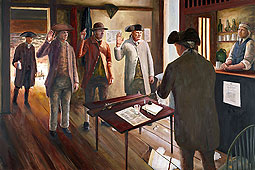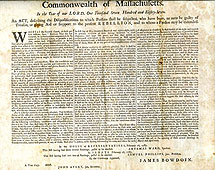For Teachers: Lessons
Lesson 6: Taking the Oath: Punishment & Appeasement
Learning Objectives
After completing this lesson, students will be able to:
- Explain why organized defiance lessened in the months following Shays’ Rebellion
- Describe the provisions of the Disqualification Act and assess its impact
- Compare and contrast the impact of the act on the majority of the Regulators and on its leaders
- Describe the “carrot and stick” approach taken by the Massachusetts government in relation to the Regulators
- Differentiate among the various terms used to label Daniel Shays and his forces
- Explain why communities tended to disregard the conditions of the Disqualification Act
- Evaluate whether or not Shays’ Rebellion was effective
Skills
- Interpreting visual information
- Observing and describing
- Thinking critically
- Expressing opinions
- Analyzing visually
- Understanding historical perspective
- Gathering and using information
- Interpreting information
Introduction
In this lesson, students learn that as armed resistance wound down in the winter of 1787, the Massachusetts government offered a pardon to rank-and-file men who had taken up arms against their government. However, men who were identified as ringleaders were imprisoned, and several were sentenced to death. The scene takes place inside Reuben Wells’ tavern in Greenfield, Massachusetts in March of 1787. A man is administering the oath of allegiance required of all Regulators, while another man records the receipt of a musket being surrendered by one of the Regulators.
 |
 |
Taking the Oath, © 2008 Bryant White |
Disqualification Act, February 16, 1787. Courtesy Petersham Historical Society, Petersham, MA |
Guiding Concepts
Although there remained sporadic incidents, open and organized defiance of the type that closed courts and confronted the Arsenal wound down in the months following General Lincoln’s rout of Shays’ men in Petersham. The Massachusetts Legislature took a carrot and stick approach to the rebellious acts—cracking down and also attempting to defuse the Regulation and neutralize the conditions that fueled it. The centerpiece of this strategy—set forth in the Disqualification Act of February 16, 1787—required all Regulators to come forward, surrender weapons, and take an oath of allegiance in exchange for a full pardon. In addition, all current and newly-elected town officials had to take the oath. A corollary of the plan was to go after and make examples of the men identified as leaders of the movement. Communities often ignored the disenfranchisement and limited activities that the Act imposed.
Preparing to Teach
- Familiarize yourself with the Taking the Oath historic scene, linked to from the Historic Scene menu. Read the three tabs, then roll your cursor over the highlighted hot spots in the illustration. Follow the links in the rollovers. Below the illustration and the tab content, read the four OBSERVER comments, the four essays in the THEMES section, and follow the links in the RELATED TO THIS SCENE section.
- Read the Disqualification Act found in the related to this scene links.
- Familiarize yourself with the Library of Congress’ Using Primary Resources.
- Although not explicitly referred to in the lesson, you can incorporate selections from the Timeline and Music section into the lesson.
Teaching the Lesson
- Class Assignment: Prior to the one or two class periods spent on this lesson, make the following website preparation assignment:
- Go to the Historic Scene menu for the Taking the Oath historic scene, and read the Overview tab, the Government tab, and the Regulators tab. Roll your cursor over the rollovers within the illustration and read the text. Note that only the highlighted rollovers for each tab display pop-ups.
- Read the observer comments, the four essays in the themes section, and follow the links in the related to this scene section, studying the material displayed.
- Read the Disqualification Act and be prepared to discuss its provisions.
- Assign each of the following characters to students (or a small group of students) so the student(s) can assume that historic persona in class: Caleb Phillips, Joseph Stebbins, Seth Catlin, and Reuben Wells. Students should read and study the narrative of their assigned persona. The character narratives are found in the People menu.
- Assign the following observers to students (or a small group of students) so the student(s) can assume that historic persona in class: George Washington, James Madison, Captain Eli Parsons, Major General Benjamin Lincoln. All of theses characters have narratives in the People menu.
- Class Activity: Trial by Jury: The Case of Henry McCulloch: Assign the following roles: a judge; a jury of 12; a prosecutor and team with legal justifications for the prosecution (proclamation 1786, proclamation 1787, death warrant, senate resolves); Henry’s defense attorney and team; McCulloch, defendant; witnesses for the accused (Sarah Peebles, Henry’s mother, a representative from the town of Pelham, Henry himself, and General Ebaneezer Mattoon); and witnesses for the state General William Shepard, Major General Benjamin Lincoln). Stage a criminal trial and have the jury vote on the outcome, explaining their vote.
- Class Activity: Primary Resource Study: Project the “List of Grievances Poem,” found in the related to this scene link section. Select students to read the poem. Project and read aloud the letter from Eli Parsons, found in the related to this scene links. Use the zoom and the transcript to examine closely the handwriting and any words you have difficulty understanding. Compare the sentiments expressed in both the poem and Eli Parsons’ letter.
- Class Activity: The Tragic Case of Jason Parmenter. Project the character narrative for Jason Parmenter. Ask students to take turns reading each paragraph. When they have completed the reading, discuss what Jason did to cause another’s death, and how that experience affected him.
- Class Discussion Questions:
- Why do you think armed conflict ceased for the most part after the events at the Arsenal?
- What effect do you think letters like that of Eli Parsons (found in related to this scene links) had in the aftermath of the rebellion?
- Did many Regulators take up the government on its offer of a pardon? What were the conditions of this pardon? (surrender guns, pay nine pence, take oath of allegiance, prohibited from running a tavern, teaching school, selling liquor, holding office or voting for three years)
- Why do you think the pardon included restrictions on teaching school and running a tavern?
- What conditions helped to minimize the effect of these provisions (new state elections, Governor Hancock elected, pardons)
- On what charge were the imprisoned leaders condemned to death? When and why did the government decide to pardon them? Do you think Henry McCulloch should have been hanged? Why or why not?
- What is your opinion of how the government of Massachusetts handled Shays’ Rebellion and those who took part in it?
Additional Resources
Books
- Gross, Robert, ed. In Debt to Shays: The Bicentennial of an Agrarian Rebellion, volume 65. Boston, MA: The Colonial Society of Massachusetts, 1993.
- Richards, Leonard. Shays’s Rebellion: The American Revolution’s Final Battle. Philadelphia: University of Pennsylvania Press, 2002.
- Starkey, Marion. A Little Rebellion. New York: Knopf, 1955.
- Satzmary, David. Shays’ Rebellion: The Making of an Agrarian Insurrection. Amherst, MA: University of Massachusetts Press, 1980.
Websites
- Library of Congress: Using Primary Resources
- Library of Congress: Digital Resources Related to the American Revolution
- Library of Congress: American Memory
- Shay’s Rebellion Song
- Best of History Websites: American Revolution and Independence
- PBS: Liberty: The American Revolution
- Edsitement: History and Social Studies
- James Madison Center: US History Curricula
- History Institute, University of Massachusetts: Shays’ Rebellion and Related Resources
Movies
- The History Channel Series: 10 Days That Changed America: Shays’ Rebellion: America’s First Civil War; 60 minutes
- Calliope: A little Rebellion Now and Then: Prologue to the Constitution; 30 minutes